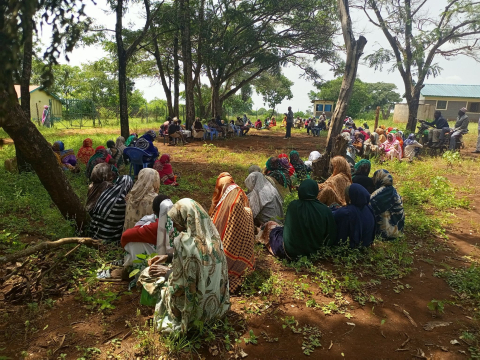Mobilising locally-led action for restoration and governance in Mount Marsabit, Kenya
Mobilising locally-led action for restoration and governance in Mount Marsabit, Kenya
Context
Water is scarce in Marsabit County, and good grazing areas for the predominantly pastoral communities are limited, especially during the dry season. The Mount Marsabit dryland forest ecosystem is an oasis in the surrounding arid and semi-arid landscape. Due to their higher elevation and proximity to the forest, the adjacent grasslands receive more rainfall. This makes them invaluable grazing areas for pastoral communities that herd their cattle in the region during the dry season.
Wildlife, including the dryland-adapted ‘special 5,’ such as the Gerenuk (which derives all its water from the plants it eats and never needs to drink), roam freely between Mount Marsabit National Park and the surrounding grasslands. This situation has led to tension, as elephants have damaged valuable infrastructure in their search for water, and hyenas occasionally hunt pastoralists' cattle. The area is critical for the livelihoods of these pastoral communities, and the increasing droughts anticipated for the region may have devastating consequences. Limited involvement of the communities in managing the area has resulted in land degradation, human-wildlife conflict, and inter-community disputes, undermining local ecosystems' adaptive capacity.
Project objectives
The project's objective is to support the creation of an inclusive and revitalised ecosystem around the Marsabit Forest, empowering Indigenous communities and enhancing their role in conservation and sustainable development. Communities are also involved in planning, managing, and monitoring their landscape. As a result, these communities become more resilient to climate change and experience improved livelihoods due to the enhanced health of the landscape.
Project activities
- Facilitate the validation and signing of a participatory forestry management plan led by the SAKU Community Forestry Association (CFA), the Kenya Forestry Service (KFS) and the Kenya Wildlife Service (KWS).
- Support communities in implementing traditional restoration techniques.
- Equip local herders with the technical skills and technology to enable them to monitor restoration progress through their herder conservation network.
Project outputs
- In September 2024, all key stakeholders signed the participatory forestry management plan (PFMP), a significant milestone after being in development for over seven years. Nature and People as One (NaPO) played a key role in facilitating the process by bringing together the stakeholders who needed to validate the plan and supporting the SAKU CFA in obtaining buy-in from their constituents.
- The project has also employed four herders as part of its herder conservation network and plans to hire 10 more. These herders are essential for engaging with local pastoral communities during their weekly expeditions through the landscape. They monitor wildlife sightings, cattle movements, fires, and signs of disease. Additionally, they upload this data to a GIS system, which assists the Kenya Wildlife Service (KWS) and Kenya Forest Service (KFS) in planning their patrols and manage the region effectively.

Community members at a participatory forestry management meeting

